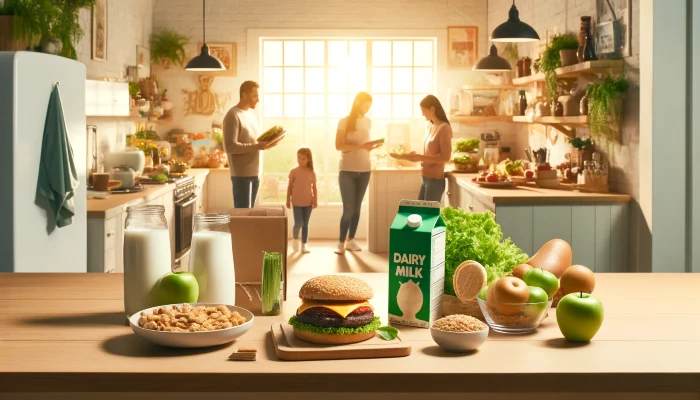Switching everyday food and drink purchases to similar but more eco-friendly alternatives could cut the greenhouse gas emissions from household groceries by more than a quarter, according to a groundbreaking Australian study. This research, conducted by The George Institute for Global Health and Imperial College London, and published in Nature Food, highlights the significant impact of making small dietary changes on our planet’s health.
Big Impact from Small Changes
Imagine reducing your grocery-related carbon footprint by 26% just by swapping out a few items in your shopping cart. This isn’t a far-fetched dream but a reality, as demonstrated by the study. The researchers found that more drastic changes—such as replacing a frozen meat lasagna with a vegetarian one—could push the reduction to as much as 71%.
However, making these changes requires on-pack labeling of greenhouse gas emissions for every packaged food product, empowering consumers to make informed choices. Lead author Dr. Allison Gaines emphasized the necessity of such labels. “Dietary habits need to change significantly if we are to meet global emissions targets, particularly in high-income countries like Australia, the UK, and US. Consumers are willing to make sustainable choices but lack the reliable information to do so.”

Comprehensive Analysis
This study represents the most detailed analysis ever conducted on the environmental impacts of a country’s food purchasing behavior. Using data from the FoodSwitch database and global environmental impact datasets, the researchers analyzed the greenhouse gas emissions and sales data for tens of thousands of supermarket products typical of Western diets.
Dr. Gaines and her team projected the emissions of annual grocery purchases from 7,000 Australian households. They used detailed information on ingredients, weights, and production life cycles.
By assigning over 22,000 products to various categories like “bread and bakery,” they quantified the emissions saved by switching within and between these groups.
Switching within the same sub-categories of foods could lead to emission reductions equivalent to taking over 1.9 million cars off the road in Australia. For more significant changes, such as switching between minor food categories, emission reductions could reach up to 71%.
The Health Connection
Importantly, Dr. Gaines noted that these environmentally friendly switches wouldn’t compromise the healthiness of the diet. We showed that you can switch to lower emissions products while still enjoying nutritious foods. In fact, we found it would lead to a slight reduction in the proportion of ultra-processed foods purchased, which is a positive outcome because they’re generally less healthy.
The study also revealed stark contrasts in the environmental impact of different food groups. Meat products, while constituting only 11% of total purchases, accounted for nearly half (49%) of all greenhouse gas emissions. In contrast, fruits, vegetables, nuts, and legumes made up a quarter of all purchases but were responsible for just 5% of emissions.
The Bigger Picture
The food and agriculture sector is responsible for about one-third of global greenhouse gas emissions. The combined health and environmental costs of the global food system are staggering, estimated between \$10 and \$14 trillion annually. Transitioning to healthy, low-emission diets could prevent over 12 million deaths each year.
Prof. Bruce Neal, Executive Director at The George Institute Australia and Professor of Clinical Epidemiology at Imperial College London, stressed the urgency of improving the sustainability of the food system. “As a global community, we are taking too long to improve the sustainability of the food system, endangering the prospect of a net-zero future. This research shows how innovative approaches can enable consumers to make a real impact.”
Tools for Change
To help consumers make better choices, The George Institute developed the ecoSwitch app, currently available in Australia.

This app allows shoppers to scan a product barcode and check its “Planetary Health Rating,” which scores the product’s emissions from half a star (high emissions) to five stars (low emissions). The George Institute plans to extend the ecoSwitch algorithm to include other environmental indicators like land and water use and biodiversity.
More To Discover
- How The Propane Industry Spent $30M On A Greenwashing Campaign To Rebrand Itself As Sustainable
- Iceland Unveils World’s Largest ‘Climate Vacuum’ to Tackle Atmospheric Carbon
- US Considers Poultry Vaccination in Response to Devastating Avian Flu Outbreak
- Beneath Our Feet: Earth’s Busiest Habitat Is In Danger
Prof. Neal envisions a future where sustainability ratings are mandatory on all supermarket products. “While ecoSwitch is a much-needed first step in providing environmental transparency for grocery shoppers, the vision is for mandatory display of a single, standardized sustainability rating system on all supermarket products,” he concluded.
8 Simple Food Swaps and Their Impact on Emissions
- Swap Beef Burgers for Plant-Based Burgers
- Impact: Reduces emissions by approximately 89%
- Explanation: Beef is one of the most carbon-intensive meats. Switching to plant-based burgers significantly cuts down emissions due to the lower environmental footprint of plant-based ingredients.
- Choose Chicken over Beef
- Impact: Reduces emissions by about 50%
- Explanation: Chicken has a lower environmental impact compared to beef. Making this switch can halve the emissions associated with your meat consumption.
- Replace Butter with Plant-Based Margarine
- Impact: Reduces emissions by up to 70%
- Explanation: The production of plant-based margarine typically has a lower environmental impact compared to dairy butter.
- Opt for Lentil Soup Instead of Beef Stew
- Impact: Reduces emissions by approximately 80%
- Explanation: Lentils are a low-emission protein source, and swapping out beef for lentils in soups and stews can drastically reduce emissions.
- Choose Frozen Vegetables Over Fresh Out-of-Season Produce
- Impact: Reduces emissions by about 30%
- Explanation: Frozen vegetables often have a lower carbon footprint than fresh produce that is out of season and needs to be transported from far away.
- Switch from Imported Fruits to Local and Seasonal Fruits
- Impact: Reduces emissions by up to 60%
- Explanation: Local and seasonal fruits require less transportation and often have a lower environmental impact than imported fruits.
- Replace Store-Bought Bread with Homemade Bread
- Impact: Reduces emissions by approximately 40%
- Explanation: Making bread at home can cut down on the emissions associated with commercial baking and packaging.
- Swap Cheese for Nutritional Yeast in Recipes
- Impact: Reduces emissions by about 50%
- Explanation: Nutritional yeast can be a lower-emission substitute for cheese in various dishes due to its plant-based nature.
By making simple food swaps and utilizing tools like ecoSwitch, consumers can play a crucial role in reducing greenhouse gas emissions and moving towards a more sustainable future.




















